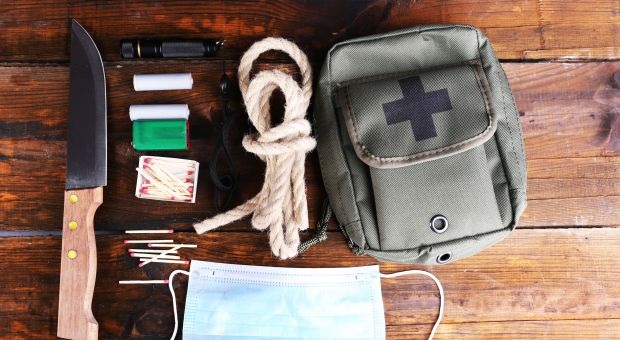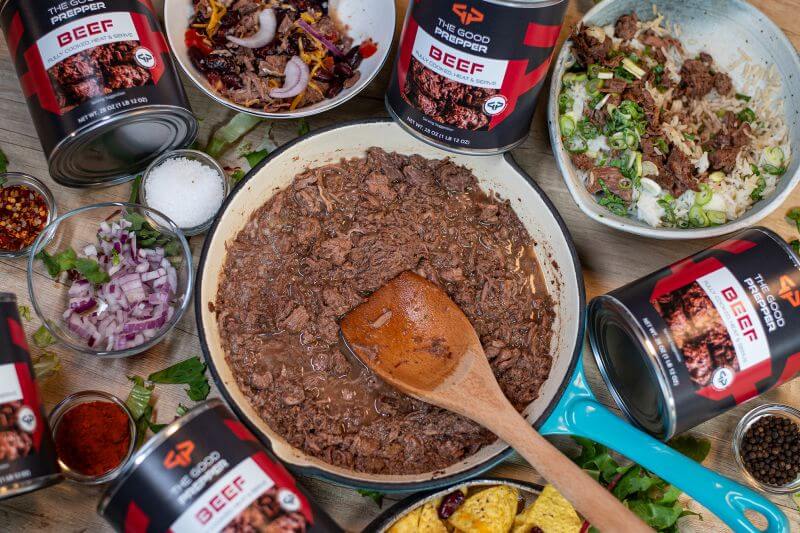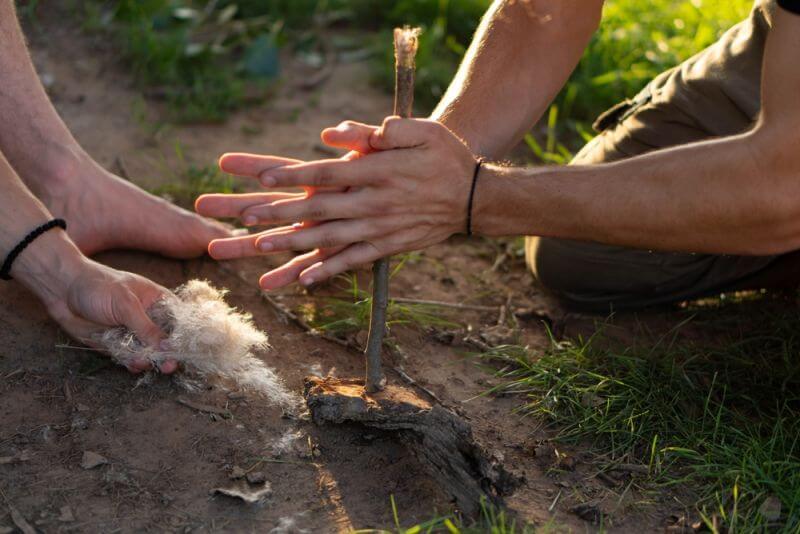Maybe you’ve been hearing about prepping for a while and you’ve finally decided you should take a closer look at it.
Or maybe you’re getting concerned about some potential disaster and how to be ready to protect your family. Perhaps you’ve got a co-worker who’s a prepper and want to know what it’s all about.
Then again, you could be one of those many people who have been meaning to get yourself more prepared for an emergency, but just never seemed to get around to it.
Regardless of how you got to where you are right now, you’re probably a bit overwhelmed if you’re just getting started in prepping. Don’t worry; we all feel that way at the beginning. There’s just too much information for any one to absorb quickly and too much to get done to make you fully prepared.
Part of that is that the world of prepping and survival has exploded in the last decade, with the amount of information, equipment and supplies that are available today being several orders of magnitude more than what they were a few short years ago. While prepping still hasn’t become mainstream by any means, more and more people are becoming interested, which has created a market for ideas, information and products.
But all those ideas and products can be pretty confusing, if you’re the one who is just getting started. Each and every one seems to be the one thing that you absolutely have to do. I get that. So let me see if I can cut through some of the fog for you and give you a good idea of where you need to start from and what you need to do first.
Before You Do Anything, Stop!
It’s very easy to feel like you’ve got to do something and run out to start spending money. Once any of us realize how unprepared we actually are, that’s a normal reaction. Just look at all the people who run to the store when a major storm is brewing. They’re unprepared and they know it; so they try and stock up on food, water and flashlight batteries. But that’s about as far as most of them go.
But before you do that, you need to have an idea of what it is that you need to do. Otherwise, chances are that you’re going to spend a lot of money on things you don’t really need, while missing some of the important things that you’ve got to have. So your first step has got to be to educate yourself.
This is a new area for you, so chances are, you don’t know a whole lot about it. So learn at least the basics of survival. What are the top survival priorities you need to concern yourself with? Should you bug out to avoid an emergency or should you plan on sheltering in place? What kinds of food do you want to avoid stockpiling for an emergency? How much water do you need? Is the zombie apocalypse real? What kinds of disasters are you likely to encounter where you live anyway?
That last question is an important one. I’ve been a survivalist for a lot of years, and I’ve seen lots of different disaster scenarios come and go. Few of those have actually panned out to be anything. Remember Y2K? That didn’t even turn out to be big enough to qualify as a fizzle; but the risk was there, so people prepared for it.
You need to make a list of all the potential disasters you can think of, from a storm knocking down the power lines to the zombie apocalypse and a comet crashing into the earth. Then, rate those on two scales (rating them from one at the low end to five at the high end): how likely they are and how serious an impact they would have on your life. Both of those ratings are important.
Add the two ratings together for each type of disaster and that gives you your risk score for each of those potential disasters. You can then sort your list by that score, putting the ones with the highest score at the top. A few examples might look something like this:
- Losing your job, but you’re at retirement age anyway – the risk is low (1), and the impact is low (1) – score = 2
- A zombie apocalypse – risk is low (1), but the impact is extremely high (5) – score = 6
- Catching the flu – risk is fairly high (4), but the impact is low (1) – score = 5
- A pandemic, such as Ebola – risk is fairly low here in the US (2), impact is high if you get it (5) – score = 7
- An EMP attack by North Korea (assuming the peace talks don’t happen) – risk is high (4), and the impact is high (5) – score = 9
When we put those in order, our priorities end up looking like this:
- EMP attack – 9
- Pandemic (Ebola) – 7
- Zombie apocalypse – 6
- Catching the flu – 5
- Losing your job – 2
Of course, your actual list would be much longer than this, but this is enough to get the basic idea. Of these five potential “disasters”, the highest priority to prepare for is an EMP attack, with a pandemic following it. Those are the priorities to prepare for. Don’t fully ignore the other potential disasters, but make sure that you cover what you’ll need for those.
Start Your Stockpile
Stockpiling for a disaster isn’t really something that ever seems to end once you start; it just keeps going on. It seems like there’s always something else you need to add to your stockpile. So it only makes sense to start with your natural inclination, which is to start building your stockpile.
Specifically, you want to start by stockpiling the things you need the most in order to survive. That means some way of keeping warm (fuel for a fire), water to drink and food to eat. While there are a lot of other things you can buy for your stockpile, those are the most important survival priorities, so you may as well start there.
Here’s where the problem comes in. You can’t just stockpile all the water you need, before moving on to food. Even though water is a higher survival priority than food is, having a year’s worth of water isn’t going to keep you alive, if you don’t have food to eat too. So you have to do your stockpiling in a parallel manner, stockpiling a little bit of each, until you reach your goal.
Let me break that down a bit more. What I mean is to start out by building a one-week stockpile of the basics: heating fuel, water and food. Once you have that, you can start filling in some of the other areas, like first-aid supplies and ammo to defend yourself. Then go back to the basics and build your stockpile up to a month. Once you’ve got it there, go back to the secondary items again and build them up to the same level. Continue alternating between basics and other items, building your stockpile a month at a time, until you reach the point where you feel you have enough.
It’s not quite that simple, because some items don’t just fit neatly into a category; but that’s the idea. Just don’t be so rigid in following it, that you lose out on a great opportunity. If you find a sale on something you need, by all means buy more than just another month’s worth of it. Take advantage of the sale. But overall, your efforts should work out to building your stockpile month by month.
One final thought, before moving on. That is, make sure that you buy the right things for your stockpile and not just whatever looks good at the time. Most of the food we all eat on a day-to-day basis won’t work for your stockpile. Rather, you’ll need to buy foods which can remain stored for a prolonged period of time, without going bad.
Equipment Trumps Supplies
While building your stockpile is important, getting the equipment you need to have, in order to survive is probably even more important. This is a slow process for most people, simply because the equipment you need isn’t exactly cheap. After all, you can buy a lot of jars of peanut butter for the cost of a good backpack.
Let me give you an example of how important the right survival equipment is. Let’s look at water. If you try to stockpile enough water to meet your family’s needs for a year, you’re probably going to need a couple of swimming pools worth of water. While most survival instructors will tell you that you need a gallon of water, per person, per day; they’re only talking about drinking and cooking. You also need water for cleaning and gardening. That works out to much more than a gallon.
Practically speaking, there’s no way to store enough water to meet your family’s needs for a year, unless you happen to own a private lake. Instead, you’re going to need some means of harvesting water and then purifying it. That way, when your stockpile of water runs out, you can fill it back up again.
The same general idea applies to food as well. While I’ve heard of people who have a 10 year stockpile of food, most of us call it quits with a year’s worth, or less. But no matter how big your stockpile of food is, you can still reach a point where you don’t have any left. What then? You have to have some means of growing more. So, in a long-term survival situation, it is your ability to grow your own food, not your food stockpile, which will keep you eating.
Knowledge Trumps Equipment
When it all comes down to it, someone has to make all that survival gear that you need. Whether we’re talking sleeping bags or firearms, it won’t make itself. But if someone else can build it, there’s a pretty good chance that you can learn how to build it too. Granted, some things require a factory full of equipment to make, but you can probably still make something simpler that can do the job.
No matter how well prepared you are, there will be things that you don’t have when the time comes. It’s inevitable. There are always things we overlook in our planning and preparation. When that comes, it is your ability to improvise, that will make a difference.
I make a lot of my own survival gear. Part of that is because I like making things; but another part is to learn how. When the time comes, I want to be able to make anything I need. As a former engineer, with a fairly good workshop, I think I’ve got a fairly good chance of meeting that goal.
There is always the possibility that when a disaster comes, it will destroy much of what you are planning on using for survival. Tornadoes, earthquakes and some other natural disasters are so severe, they can eliminate your home and everything in it. While chances are slim that such a thing will ever happen to you or me, the possibility does exist. Should that happen, all we would be left with is the survival knowledge we’ve been able to learn.
Likewise, we could find ourselves suddenly thrust into a survival situation, where we don’t have our stockpile and equipment ready at hand. What if something happens while on vacation? I always bring a survival kit with me, but that’s not the same as being at home, with all my gear and supplies at hand. In such a case, it’s survival knowledge that’s going to make the difference between life and death.
Don’t Forget, This is Survival
It is easy to get sidetracked on the road to preparedness. One of the most common ways of becoming sidetracked is to forget that what you’re preparing for is to survive, thinking that you have to be able to live the way you are living today. While being able to do that would be nice, focusing on that could destroy your ability to do what you have to do to survive.
Take solar panels as an example. I’ve got nothing against solar power. I use it and I’m working on building more panels to expand my power production. But there’s no way that I can see that I’ll ever have enough panels to power everything in my home.
When push comes to shove, I actually don’t have to have solar power to survive. What they’ll do is make it easier to survive. But I can still pump my water, without an electric pump. I can still cool my food without a refrigerator. I can even build things without my power tools. About the only thing I can’t do without electricity is to use my smartphone and get on the internet. But I’m pretty sure I can survive without it.
So, while it’s a great idea to have solar power and a battery backup system, it is not a survival essential. Therefore, don’t let buying those solar panels take priority over buying food. Put them on the “nice to have” list, rather than the “have to have” one. Then, when you get a little farther down the road towards being prepared, you can add those to your available equipment.








Todd McGann | June 5, 2018
|
Eccellent article
looter | June 5, 2018
|
very nice well done article. great advice for new peppers and good reminder for those more experienced. seems most of these articles are written by people in cold climates, those of us in the deep South never get cold enough to have heating that high on the list though.
Kentucky Dave | June 5, 2018
|
Great article! I often wonder if I will be prepared if SHTF. The more I read, the better I feel about it. I hoard things that may be useful. So far, so good. Thanks, Bill,.
Grammyprepper | June 6, 2018
|
Jim Cobb just posted an article about the most common beginning prepper mistakes, and I identified with every single one. I went all ‘crazy’ at the beginning of my prepping journey, and got burned out with all the ‘doom and gloom’ stuff. Also faced my own personal SHTF situation with a job loss. Preps saved our butts. BUT I also left a lot of prepping sites because of ppls attitudes. THIS is one of the few prepping sites I continue to follow. Might I suggest, if one is feeling overwhelmed with the prepping side of things, that you in turn look into homesteading sites? While Survivopedia is a relatively non-judgemental and informational site, most homesteading groups are way less judgemental than most prepping sites. Prepping and homesteading are not mutually exclusive. The goals are the same, the ways of getting there differ a bit.
Hoss | June 11, 2018
|
Great comment. I too always consider them going hand in hand. Prepping is a way of life. Not something you just do.
C Schultz | June 6, 2018
|
Super information for anyone just starting out. I’m very new to the idea of prepping and this put a lot of things into perspective! Thanks so much!
Andrew Clark | June 7, 2018
|
This is a great article! It’s often difficult to keep things balanced and in perspective.
My wife lived through the collapse of the Soviet Union and hearing her stories really made me understand the need to start prepping.
One of my favorite prepping books is The Lost Ways by Claude Davis. It takes a very practical and traditional approach to prepping without all the hysteria. You can learn more about his book here https://bit.ly/2sNEDX7